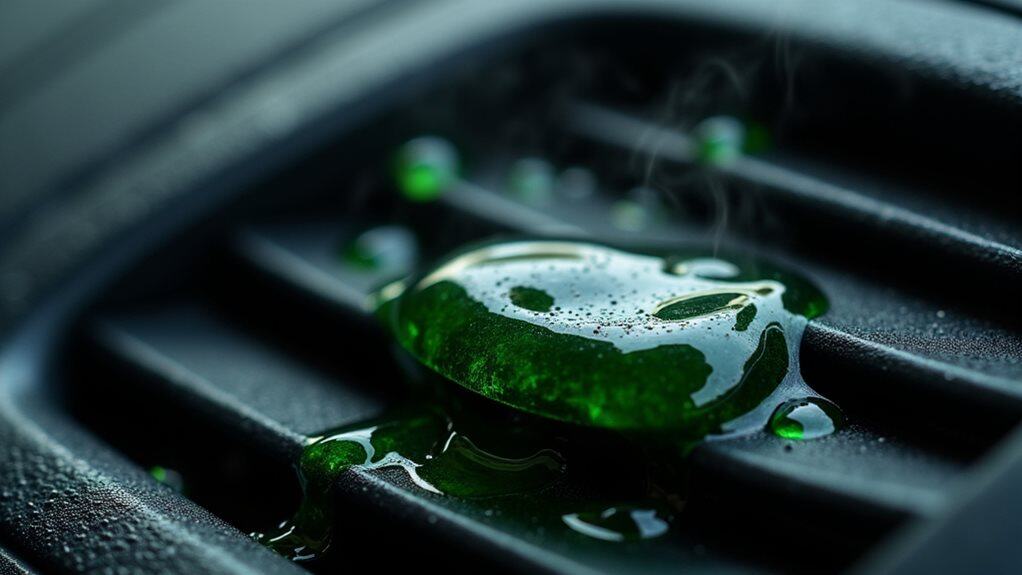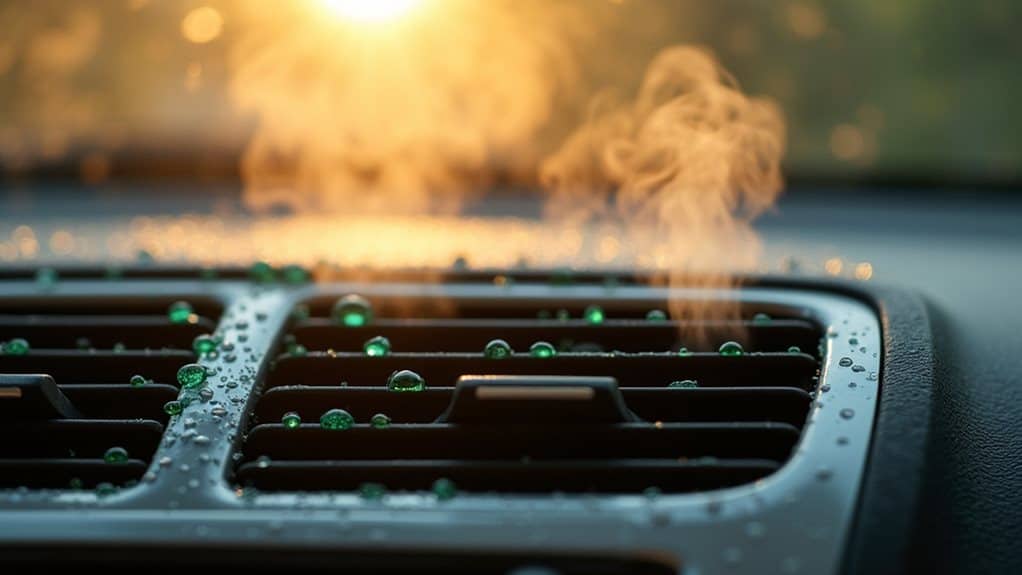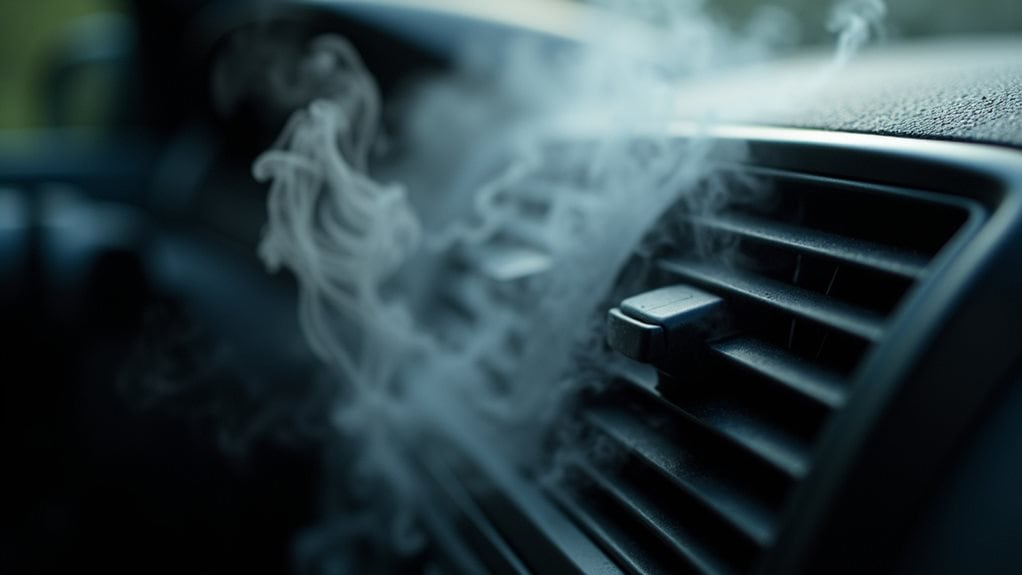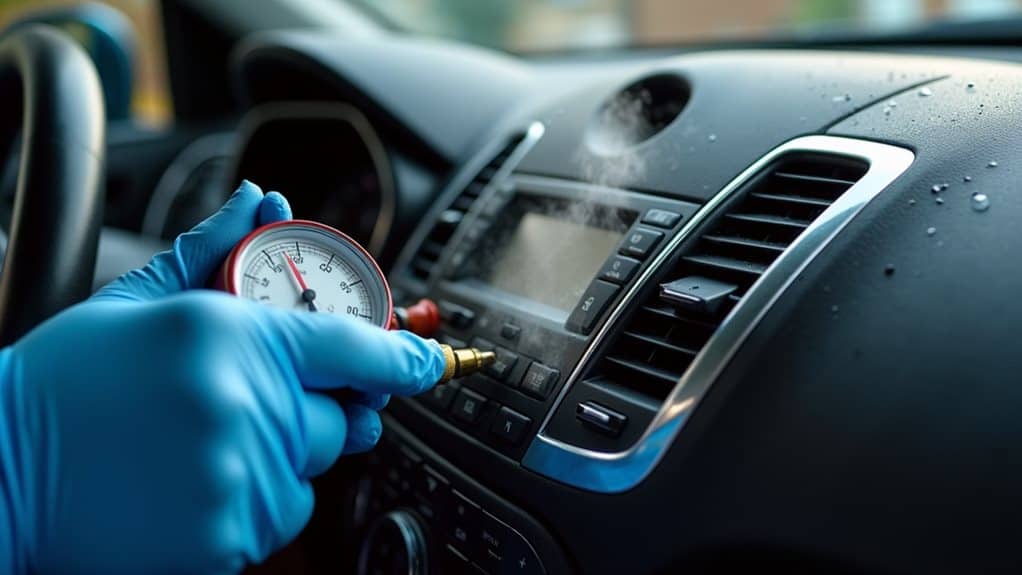That sweet, syrup-like smell from your car’s vents indicates a coolant leak, most commonly from a failing heater core that’s allowing toxic ethylene glycol vapors into your cabin. You might also notice a slimy film on windows, damp passenger-side carpet, or dropping coolant levels. Other causes include worn radiator cap seals, cracked coolant reservoirs, or deteriorated hoses. Since antifreeze fumes can cause headaches, nausea, and serious respiratory issues, you’ll want to investigate thorough diagnostic methods and repair solutions.
Quick Tips
- A sweet aroma from vents indicates ethylene glycol leaking from the cooling system into the cabin’s ventilation system.
- Heater core failure causes coolant leaks, creating sweet odors, damp passenger-side carpets, and foggy windows.
- Worn radiator cap seals allow coolant vapors to escape, leading to pressure loss and distinctive smells.
- Cracked coolant reservoirs or deteriorated hoses leak antifreeze, producing odors that enter through cabin vents.
- Internal engine block leaks cause coolant to mix with oil or enter combustion chambers, creating ventilation odors.
What That Sweet Smell in Your Car Really Means

That unmistakable sweet aroma wafting from your car’s vents isn’t air freshener or spilled soda—it’s most likely ethylene glycol from your vehicle’s cooling system. This toxic chemical compound, which makes up half of your antifreeze mixture, creates a distinctly sweet odor when it leaks or evaporates into your cabin’s ventilation system. A slimy film on your windows is another telltale sign that your heater core needs replacement. It’s important to address engine cooling system issues promptly, as neglecting them can lead to serious engine damage.
Most Common Culprit: Leaking Heater Core
When you smell that distinctive sweet antifreeze odor coming through your vents, the heater core is likely the culprit since it’s a small radiator that circulates hot coolant to warm your cabin. It’s worth noting that a fully dressed Chevy 350 engine can weigh between 600-650 pounds, which is important to consider if you’re working on a vehicle with this engine. You’ll need to watch for telltale signs like damp carpet on the passenger side, foggy windows, and mysteriously dropping coolant levels that confirm this diagnosis. A cold cabin despite your engine running hot is another clear indicator that your heater core has failed and can no longer transfer heat effectively to warm your vehicle’s interior. The repair decision then comes down to whether you can temporarily manage the leak with stop-leak additives or if you need the more expensive but permanent solution of complete heater core replacement.
Heater Core Function
The heater core functions as your vehicle’s miniature radiator, tucked away inside the dashboard where it converts hot engine coolant into warm cabin air.
Hot coolant circulates through the core’s metal tubes while your blower fan pushes air across its surface, transferring heat. This process delivers warm air at nearly 200°F into your cabin.
Leak Detection Signs
Several telltale signs can help you identify a leaking heater core, which accounts for roughly 80% of coolant smell issues coming from your vehicle’s vents.
You’ll notice a distinct sweet antifreeze odor intensifying when using heat or defrost.
Check for damp carpeting beneath the dashboard, especially passenger-side, and monitor coolant levels for unexplained drops.
Replacement Vs Repair
Once you’ve confirmed a leaking heater core through the telltale signs, you’ll face a critical decision between repair and complete replacement.
Clogged cores might respond to flushing, but leaking cores typically require full replacement.
While repair costs less initially, it rarely provides lasting solutions.
Replacement costs $800-$1,000 but restores system integrity and eliminates recurring issues.
Radiator Cap Issues That Create Coolant Odors
Your radiator cap performs a critical function by maintaining proper system pressure and sealing the cooling system.
However, when its rubber seals wear out or the spring tension weakens, it can’t hold pressure effectively and allows coolant vapors to escape.
This pressure loss not only reduces the coolant’s boiling point but also permits sweet-smelling antifreeze odors to enter your cabin through the ventilation system, especially when the faulty cap allows coolant to leak onto hot engine components.
Fortunately, diagnosing radiator cap problems involves simple visual inspection and pressure testing, while replacing a worn cap with the manufacturer-recommended model typically resolves these odor issues quickly and affordably. Additionally, ensuring that the power steering fluid is free from contamination can help maintain overall vehicle performance and prevent unpleasant odors.
Worn Cap Seal Problems
When your radiator cap seal deteriorates from repeated heat and pressure cycles, it creates a cascade of problems that can fill your cabin with that distinctive sweet coolant smell.
The worn seal can’t maintain proper pressure, allowing coolant to leak and evaporate around the cap area, sending antifreeze vapors through your ventilation system.
Improper Pressure Release
A deteriorating seal represents just one way radiator cap problems can introduce coolant odors into your vehicle’s cabin.
When your cap fails to release pressure at its designated PSI rating, excessive pressure buildup forces coolant out through weak system points.
This malfunction prevents proper coolant circulation, creating overheating conditions while allowing antifreeze vapors to infiltrate your cabin’s air circulation system.
Cap Replacement Solutions
Once you’ve identified that your radiator cap is causing coolant odors, replacing it becomes the most straightforward and cost-effective solution.
You’ll need to match the OEM specifications exactly, including pressure ratings and dimensions.
A properly fitted replacement cap with new seals and gaskets will restore system integrity, eliminate leaks, and stop coolant smells immediately.
Coolant Reservoir Problems and Warning Signs
Although coolant reservoirs appear to be simple plastic containers, they play a critical role in maintaining your vehicle’s cooling system pressure and preventing engine overheating.
When reservoirs crack or leak, you’ll notice visible coolant dripping, frequent refilling needs, sweet odors from vents, dashboard warning lights, and colored puddles beneath your vehicle indicating immediate attention’s required. Regularly monitoring coolant levels is essential to avoid serious engine damage and overheating risks.
Engine Block Leaks and Their Distinctive Symptoms

When you’re dealing with engine block leaks, you’ll notice distinctive symptoms that set them apart from typical coolant system problems.
Internal leak detection signs include milky oil on your dipstick where coolant has mixed with engine oil, erratic misfires caused by coolant entering combustion chambers, and combustion gases contaminating your coolant system.
These symptoms create serious overheating risks because compromised coolant circulation can’t properly regulate your engine temperature, leading to persistent warning light activation and potential engine damage.
Internal Leak Detection Signs
While external coolant leaks often announce themselves with visible puddles and obvious drips, internal engine block leaks present a more challenging diagnostic puzzle that requires careful observation of multiple interconnected symptoms.
You’ll notice persistent overheating, milky oil contamination, white exhaust smoke, power loss, and misfiring.
These signs indicate coolant entering combustion chambers through cracked block walls.
Overheating Risk Indicators
Because engine block leaks represent one of the most serious threats to your vehicle’s cooling system, recognizing their distinctive overheating symptoms becomes essential for preventing catastrophic engine damage.
You’ll notice your temperature gauge climbing into the red zone, while dashboard coolant warning lights activate.
Steam emerges from under the hood, accompanied by burning antifreeze odors.
Damaged Coolant Hoses Near Your Heating System
Although coolant hoses are designed to withstand extreme temperatures and constant pressure, they’re particularly vulnerable to damage near your vehicle’s heating system where heat stress reaches its peak.
You’ll notice physical signs like cracking, bulging, or a spongy feel when squeezed.
These deteriorated hoses often leak coolant, creating that distinctive antifreeze odor entering your cabin vents.
Recognizing the Telltale Signs of Coolant Problems

When troubleshooting coolant smell from your vehicle’s vents, you’ll need to identify several key indicators that point to coolant system problems.
Look for sweet, syrup-like odors emanating from air vents, which suggests heater core failure.
Check for colored fluid pooling beneath your parked car, gurgling engine noises, and dropping coolant reservoir levels without visible leaks.
Why Your Engine Might Be Overheating
While coolant smell from your vents signals a problem, understanding the underlying cause of engine overheating will help you diagnose and address the issue effectively.
Your engine overheats when cooling system components fail, including broken water pumps, clogged radiator fins, or stuck thermostats.
Low coolant levels and contaminated fluid also reduce heat transfer capacity, causing dangerous temperature spikes.
Health Risks of Breathing Coolant Fumes

Since ethylene glycol serves as the primary component in most automotive coolants, breathing these fumes poses serious health risks that you shouldn’t ignore.
Inhaling coolant vapors can cause immediate symptoms like headaches, nausea, coughing, and respiratory irritation.
Severe exposure leads to neurological effects including seizures, loss of consciousness, and potentially fatal outcomes requiring immediate medical intervention.
How to Inspect Your Cooling System for Leaks
The cooling system inspection process requires a systematic approach to identify potential leak sources that could allow coolant fumes to enter your vehicle’s cabin.
Start by examining the engine bay for wet spots, focusing on the radiator, hoses, and water pump.
Check underneath your vehicle for coolant puddles, then inspect hose connections and clamps for tightness.
Professional Diagnostic Tests You Should Know About

When your visual inspection doesn’t reveal the source of that coolant smell coming through your vents, professional diagnostic tests can pinpoint problems that aren’t visible to the naked eye.
Mechanics use pressure testing to detect hidden leaks, UV dye detection to trace coolant paths, and block testing to identify head gasket failures causing internal coolant seepage.
Effective Repair Solutions and Prevention Tips
After professional diagnostics confirm the source of your coolant smell, you’ll need to choose between temporary fixes and permanent solutions based on the severity of the leak and your immediate driving needs.
Temporary repairs include radiator sealants and rubber tape around hoses, while permanent solutions involve replacing worn components like hoses, radiator caps, or head gaskets completely.
Wrapping Up
You’ve learned that coolant odors from your vents typically indicate serious cooling system problems requiring immediate attention. Whether it’s a failing heater core, damaged radiator cap, or cracked engine block, you shouldn’t ignore these warning signs. The sweet smell poses health risks, and delays can lead to costly engine damage. Inspect your system regularly, monitor coolant levels, and consult a professional mechanic when you detect any unusual odors from your vehicle’s ventilation system.

